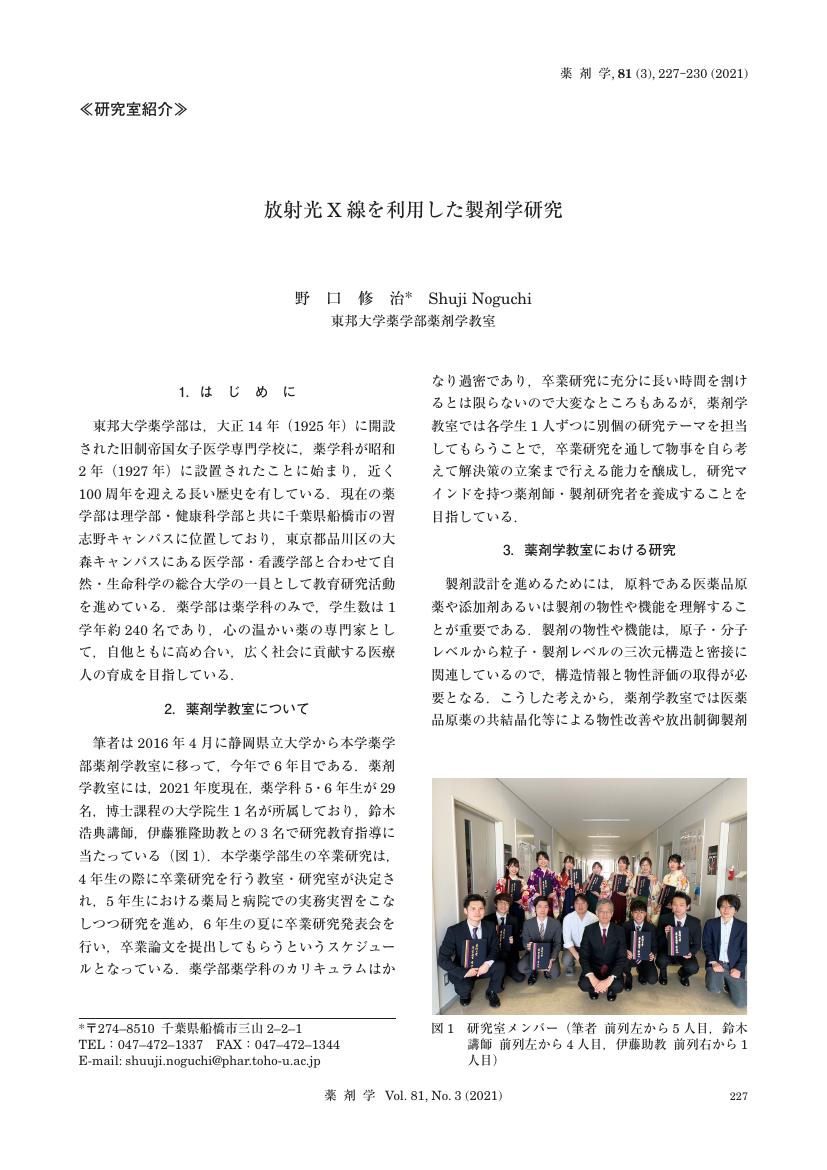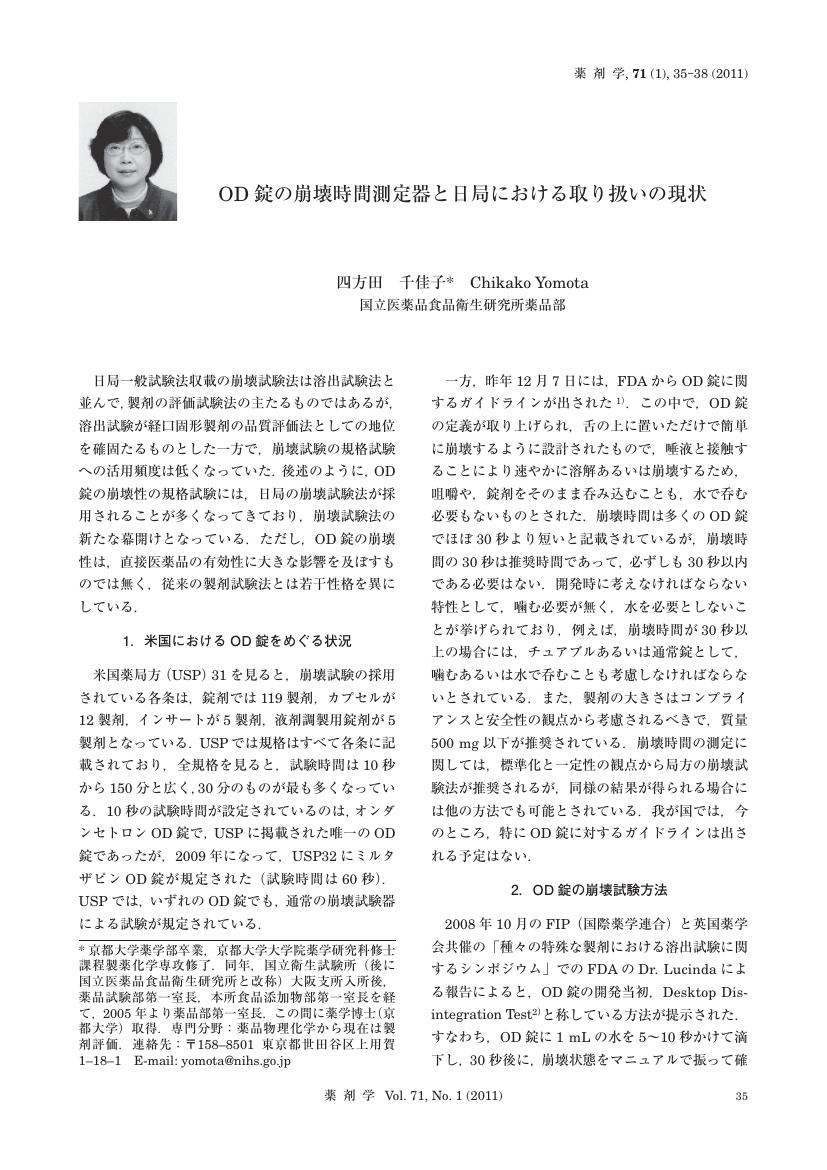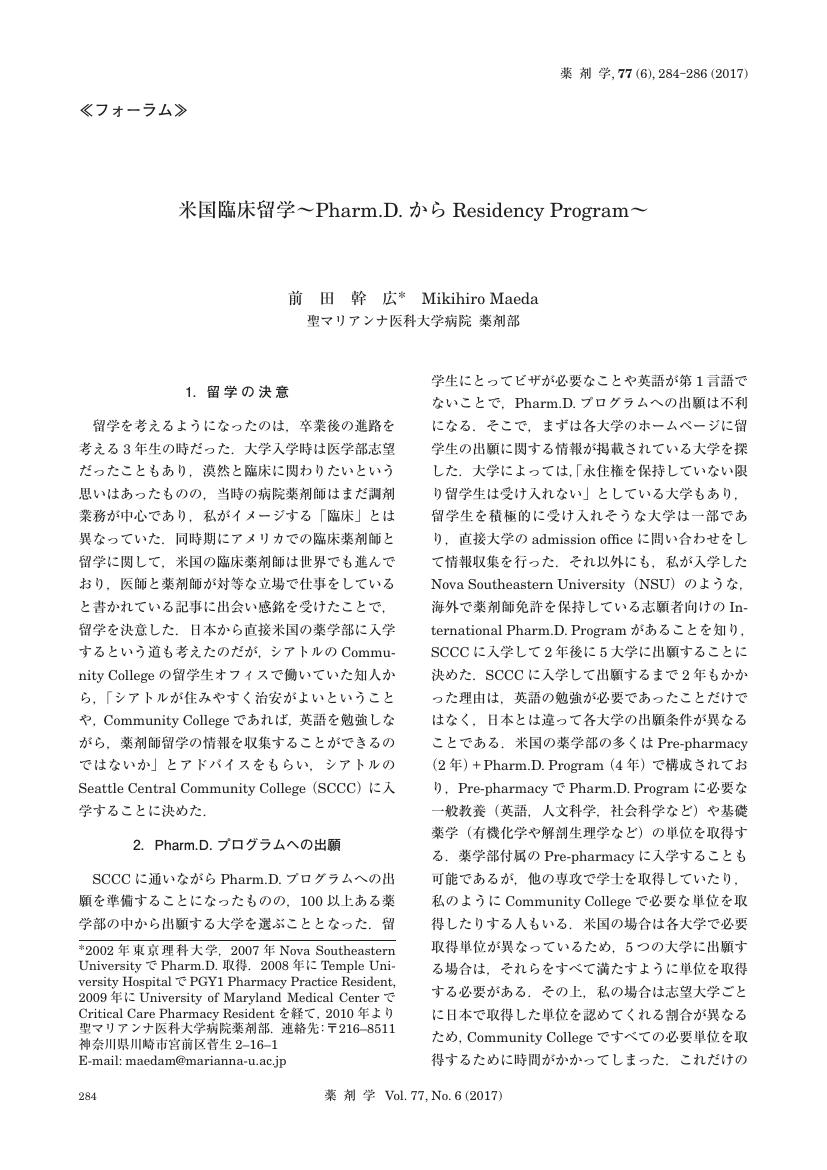1 0 0 0 OA 薬学教育6年制の導入
- 著者
- 田中 克平
- 出版者
- 公益社団法人 日本薬剤学会
- 雑誌
- 薬剤学 (ISSN:03727629)
- 巻号頁・発行日
- vol.64, no.6, pp.326-331, 2004 (Released:2019-05-10)
- 参考文献数
- 1
- 被引用文献数
- 2
1 0 0 0 OA 室温保存を可能としたラタノプロスト点眼液の製剤設計
- 著者
- 落合 明子 飯田 桂 髙部 浩行 川村 恵里 佐藤 康彦 加藤 保富 大熊 盛之 檀上 和美
- 出版者
- 公益社団法人 日本薬剤学会
- 雑誌
- 薬剤学 (ISSN:03727629)
- 巻号頁・発行日
- vol.70, no.6, pp.324-331, 2010 (Released:2019-03-08)
- 参考文献数
- 18
Latanoprost tends to degrade in an aqueous solution, and also adsorbs to the plastic containers. Moreover, the latanoprost content of the formulation can easily degrade, depending on the storage temperature, because of the very low drug concentration in the eye drops. Therefore, Xalatan® Eye Drops should be stored at 2-8°C (in the refrigerator)for the reasons described above.In this study, we investigated ways to improve the stability of latanoprost in aqueous solution in order to develop a formulation of latanoprost eye drops that can be stored at room temperature (1-30°C). Excipients used for opthalmological preparations were examined. The stability at 60°C was evaluated after 4 weeks in model formulations that included the excipient, which enables sterile filtration. As a result, the latanoprost content was not decreased in formulations that included polyoxyl 40 stearate and polyethylene glycol monostearate 25 at suitable concentrations. Then, we established a formulation of latanoprost eye drops that could be stored at room temperature. It was assumed that both the degradation of latanoprost and adsorption to the plastic containers were depressed by these excipients.The formulation developed in this study would not need to be stored in the refrigerator either during the medication period of the patient or during distribution and storage at medical sites. It was also predicted that instructions on the use of these drugs would be simplified. Therefore, the latanoprost eye drops developed in this study would be very useful for patients and health care professionals.
1 0 0 0 OA がん専門薬剤師制度の紹介
- 著者
- 河原 昌美
- 出版者
- 公益社団法人 日本薬剤学会
- 雑誌
- 薬剤学 (ISSN:03727629)
- 巻号頁・発行日
- vol.80, no.4, pp.198-202, 2020 (Released:2020-07-01)
- 参考文献数
- 4
1 0 0 0 OA 薬物排出トランスポーターと薬物間相互作用
- 著者
- 高田 龍平 鈴木 洋史
- 出版者
- 公益社団法人 日本薬剤学会
- 雑誌
- 薬剤学 (ISSN:03727629)
- 巻号頁・発行日
- vol.65, no.6, pp.375-380, 2005 (Released:2019-04-20)
- 参考文献数
- 16
- 被引用文献数
- 1
1 0 0 0 OA 放射光X線を利用した製剤学研究
- 著者
- 野口 修治
- 出版者
- 公益社団法人 日本薬剤学会
- 雑誌
- 薬剤学 (ISSN:03727629)
- 巻号頁・発行日
- vol.81, no.3, pp.227-230, 2021-07-01 (Released:2021-07-01)
- 参考文献数
- 4
1 0 0 0 OA 薬物の経毛嚢送達:ヒト頭皮薬物吸収の特性と利点
- 著者
- 小木曽 太郎
- 出版者
- 公益社団法人 日本薬剤学会
- 雑誌
- 薬剤学 (ISSN:03727629)
- 巻号頁・発行日
- vol.63, no.1, pp.34-45, 2003 (Released:2019-05-12)
- 参考文献数
- 31
Recent studies have focused on the hair follicle as a potential pathway for both localized and systemic drug delivery. When drug penetration through human scalp skin was investigated using liquid formulations containing lipophilic and hydrophilic drugs in vitro, lipophilic melatonin (MT) and ketoprofen (KP) showed high permeabilities through scalp skin. Absorption enhancers, N-methyl-2-pyrrolidone and isopropylmyristate, only slightly increased the fluxes. Hydrophilic fluorouracil (5FU) and acyclovir (ACV) also penetrated across the skin with relatively large fluxes. However, there was large variability in the fluxes of drugs across scalp skins. There was a correlation between the flux and hair follicle density (r=0.651 for MT and r=0.666 for ACV). Fluorescent probes, nile red and sodium fluorescein, permeated into the junction of the internal and external root sheath of follicles and diffused into the dermis via the outer root sheath at the initial times. The penetration of MT and 5FU through scalp skin was much higher (37 and 48 times, respectively) than that via human abdominal skin. It has been demonstrated that topically-applied liposomes and microspheres are efficient in specifically targeting the delivery of a wide variety of compounds into the hair follicles. Additionally, hair follicles were a significant pathway for electroosmotic solution flow during iontophoresis. This review indicates a basis that drug delivery through human scalp skin will offer an available delivery means for many lipophilic and hydrophilic drugs.
1 0 0 0 OA 特集号「進化するペプチド・抗体医薬品開発」用語解説
- 著者
- 薬剤学編集委員会
- 出版者
- 公益社団法人 日本薬剤学会
- 雑誌
- 薬剤学 (ISSN:03727629)
- 巻号頁・発行日
- vol.74, no.1, pp.63-65, 2014 (Released:2014-07-01)
1 0 0 0 OA 薬物間相互作用の定量的予測をめざして
- 著者
- 伊藤 清美
- 出版者
- 公益社団法人 日本薬剤学会
- 雑誌
- 薬剤学 (ISSN:03727629)
- 巻号頁・発行日
- vol.64, no.1, pp.36-39, 2004 (Released:2019-05-10)
- 参考文献数
- 5
1 0 0 0 OA OD錠の崩壊時間測定器と日局における取り扱いの現状
- 著者
- 四方田 千佳子
- 出版者
- 公益社団法人 日本薬剤学会
- 雑誌
- 薬剤学 (ISSN:03727629)
- 巻号頁・発行日
- vol.71, no.1, pp.35-38, 2011 (Released:2019-03-02)
- 参考文献数
- 7
- 被引用文献数
- 1
1 0 0 0 OA 薬剤師は科学者である―科学を築いた薬剤師または薬局助手―
- 著者
- 永井 恒司
- 出版者
- 公益社団法人 日本薬剤学会
- 雑誌
- 薬剤学 (ISSN:03727629)
- 巻号頁・発行日
- vol.64, no.1, pp.27-28, 2004 (Released:2019-05-10)
1 0 0 0 OA 医薬品の連続生産―現状と将来展望―
- 著者
- 松井 康博
- 出版者
- 公益社団法人 日本薬剤学会
- 雑誌
- 薬剤学 (ISSN:03727629)
- 巻号頁・発行日
- vol.79, no.6, pp.300-304, 2019 (Released:2019-11-01)
- 参考文献数
- 5
1 0 0 0 OA 小児麻酔前投薬に用いるクロニジン製剤の調製と臨床評価
- 著者
- 住谷 賢治
- 出版者
- 公益社団法人 日本薬剤学会
- 雑誌
- 薬剤学 (ISSN:03727629)
- 巻号頁・発行日
- vol.70, no.4, pp.229-234, 2010 (Released:2019-03-08)
- 参考文献数
- 5
1 0 0 0 OA 米国臨床留学~Pharm.D.からResidency Program~
- 著者
- 前田 幹広
- 出版者
- 公益社団法人 日本薬剤学会
- 雑誌
- 薬剤学 (ISSN:03727629)
- 巻号頁・発行日
- vol.77, no.6, pp.284-286, 2017-11-01 (Released:2017-11-01)
- 参考文献数
- 1
- 著者
- 杉林 堅次
- 出版者
- 日本薬剤学会
- 雑誌
- 薬剤学 (ISSN:03727629)
- 巻号頁・発行日
- vol.67, no.2, pp.89-95, 2007
皮膚局所に適用する医薬品製剤には, 皮膚組織やその周辺部位での薬効(局所作用)を期待するものだけでなく, いわゆる全身作用を期待する経皮吸収型製剤(Transdermal Drug Delivery Systems, TDS)があり, さらに, 最近では機能性を有する化粧品も市場を賑わすようになってきた. したがって, 現在では, 治療薬だけでなく化粧品有効成分の皮膚透過性や経皮吸収性を正しく評価する方法論の確立が以前にも増して必要とされるようになった. また一方で, 効果が高くなれば皮膚局所での刺激性などの副作用についても正しく予測することが重要となり, 加えて, 主薬およびその濃度, さらには基剤の選択基準の確立が必要となってきた. 現在, 薬物の皮膚透過量や透過速度はヒト皮膚を用いて主にin vitro実験法で評価されている. しかし, 特に本邦では新鮮なヒト皮膚が必要な量を入手できるとは限らない. そこで, 動物皮膚や人工膜が使われることとなるが, 動物皮膚使用に当たっては動物愛護の問題を回避することができないし, また, 人工膜の使用では代謝酵素やトランスポーターが関与する皮膚透過を表現することができない.
1 0 0 0 OA 旭化成製剤学奨励賞を受賞して シュガーレス薄層糖衣錠の開発
- 著者
- 大森 真治
- 出版者
- 公益社団法人 日本薬剤学会
- 雑誌
- 薬剤学 (ISSN:03727629)
- 巻号頁・発行日
- vol.64, no.3, pp.146-149, 2004 (Released:2019-05-10)
- 参考文献数
- 6
1 0 0 0 OA 消化管の吸収促進剤について
- 著者
- 宇都口 直樹
- 出版者
- 公益社団法人 日本薬剤学会
- 雑誌
- 薬剤学 (ISSN:03727629)
- 巻号頁・発行日
- vol.65, no.2, pp.106-109, 2005 (Released:2019-04-20)
- 参考文献数
- 6
1 0 0 0 OA 健康寿命の延伸と機能性食品の補完医療的効用
- 著者
- 山田 静雄
- 出版者
- 公益社団法人 日本薬剤学会
- 雑誌
- 薬剤学 (ISSN:03727629)
- 巻号頁・発行日
- vol.77, no.5, pp.264-269, 2017-09-01 (Released:2017-09-01)
- 参考文献数
- 5
1 0 0 0 OA 経粘膜ワクチンデリバリー製剤の開発の現状と今後の展望
- 著者
- 國澤 純 平田 宗一郎 清野 宏
- 出版者
- 公益社団法人 日本薬剤学会
- 雑誌
- 薬剤学 (ISSN:03727629)
- 巻号頁・発行日
- vol.76, no.1, pp.11-17, 2016 (Released:2016-07-01)
- 参考文献数
- 22
1 0 0 0 近赤外光線免疫療法による新規がん治療
- 著者
- 小林 久隆
- 出版者
- 公益社団法人 日本薬剤学会
- 雑誌
- 薬剤学 (ISSN:03727629)
- 巻号頁・発行日
- vol.76, no.3, pp.172-176, 2016
1 0 0 0 OA 口内炎発症予防および治療を目的とした病院薬局製剤
- 著者
- 花輪 剛久
- 出版者
- 公益社団法人 日本薬剤学会
- 雑誌
- 薬剤学 (ISSN:03727629)
- 巻号頁・発行日
- vol.65, no.1, pp.43-47, 2005 (Released:2019-04-20)
- 参考文献数
- 25















